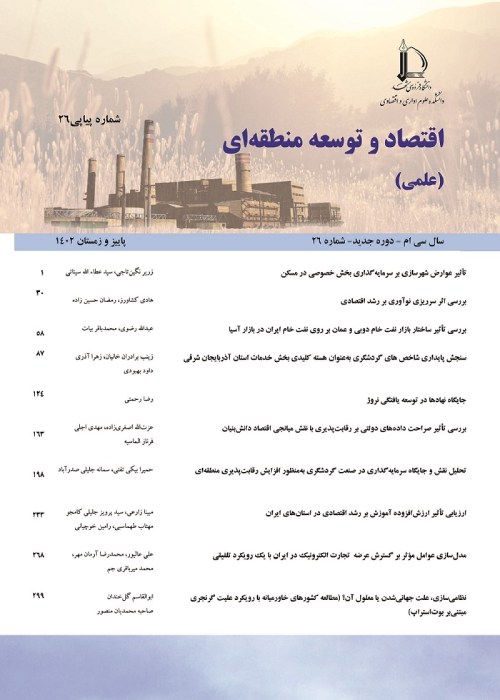Identifying the priorities of investment in the automotive parts manufacturing industry in Semnan province using VAHP method: Resistance economy-based approach
Identifying regional investment priorities is one of the best ways to exploit the potential of regions, which allows for the correct management of resources. The wide and diverse range of industries and the constraints on providing the resources needed for investment have made investing prioritization a necessity. The main issue of this paper is to examine the investment priorities in the auto parts manufacturing industry in Semnan province with criteria derived from the resistance economy. Semnan province due to its convenient geographical location (proximity to the location of automotive companies) and high production value has become the fifth hub of the country's auto parts industry and has a good capacity for future investments.
Theoretical framework:
Spatial planning, land use planning and distribution of economic activities and resources need to take into account the cultural, political, and economic conditions of the country. After the Islamic Revolution, Iran has always been subject to sanctions and political, economic and social pressures, and the government's strategy to deal with such pressures has been the policies and strategies of the resistance economy. It is natural that the issue of land management specially determining investment priorities, should follow such policies.Semnan Auto Parts Group has 105 companies that are active in the field of production of auto accessories, parts and assemblies, and the transportation industry. The employment level of these units is over 6000 people who have more than 95% of the employment share of the cluster. Despite the great importance of auto parts industries in Semnan province, the development and expansion of these industries are facing important problems, the most important part of which is the lack of clear investment priorities in Semnan province. Setting these priorities plays an important role in improving efficiency and productivity, reducing costs, and completing the cluster chains of this area of the province's industry.The resistance economy has components that need to be considered in determining investment priorities in Semnan province. These components are: being knowledge-based, being based on the private sector, being justice-oriented, endogenous, extroverted, and making the country resilient to threats. Prioritization of investment in the auto parts industry in Semnan province should be done in a way that increases the role of knowledge-based industries, an important part of this investment should be done by the private sector, priority should be given to industries that take the country out of corruption, rent and monopoly And make the best use of domestic resources, at the same time make good use of foreign capacities and markets, and finally make the country resilient to shocks and sanctions.
The method used to achieve the goal of this research is the Voting Analytic Hierarchy Process (VAHP) that allows the simultaneous use of multiple criteria and can therefore include a set of components of the resistance economics. This method needs 6 Steps: 1) Selecting the prioritization criterion. 2) Configuring the hierarchy of criteria. 3) Determining the priority and ranking of criteria. 4) Calculating weights (Noguchi ranking). 5) Determining the production methods and mechanisms of each. 6) Set priorities by using exports opinion.
Data analysis from expert opinions using the above method shows the production of 1) electronic and electrical parts, 2) casting and machining, 3) heat treatment, 4) cold and hot forging and 5) mechanical and electromechanical parts, respectively, are the 5 main investment priorities in the auto parts industry in Semnan province. In determining these priorities, the criterion of knowledge-based economy and endogeneity has the highest weight.
Conclusions and suggestions:
This article identified investment priorities in the auto parts industry in Semnan province based on the components of a resistance economy. Furthermore, this research can be used for future research in three aspects. The first aspect is related to the research method that used VAHP. This research method, using the Noguchi scoring approach, has simplified the possibility of measuring priorities in different sectors, and for this reason, researchers are suggested to use this method and its benefits. The second aspect of this research is the subject of the automotive industry in Iran. This study examined the investment priorities in the auto parts industry and determined which of these products could be prioritized. The achievements of this research can be used as a presupposition of many other pieces of research and can examine issues such as prioritizing the purchase of raw materials, creating industrial clusters related to the automotive industry in the province and also the advantages of establishing an automotive industry in the province. The third aspect of this research is the link between prioritization and components of resistance economics that can be used as a basis for other research.
-
گذار از عقود مبادله ای به مشارکتی در بانکداری اسلامی و آثار آن بر نابرابری اقتصادی در ایران
*
نشریه معرفت اقتصاد اسلامی، بهار و تابستان 1402 -
Transition Policy and Banking Stability: A New Approach to Policy Making in Islamic Banking
Mohsen Asadian, *
Iranian Economic Review, Spring 2024 -
A new interval for ranking alternatives in multi attribute decision making problems
*
Journal of Applied Research on Industrial Engineering, Winter 2024 -
Improved WASPAS method for determining criteria priority and weights in solving MADM problems: a case study to determine leadership style in Covid-19 pandemic
*, Seyyed Mohammad Zargar, Maryamsadat Aman
Journal of Decisions and Operations Research,




